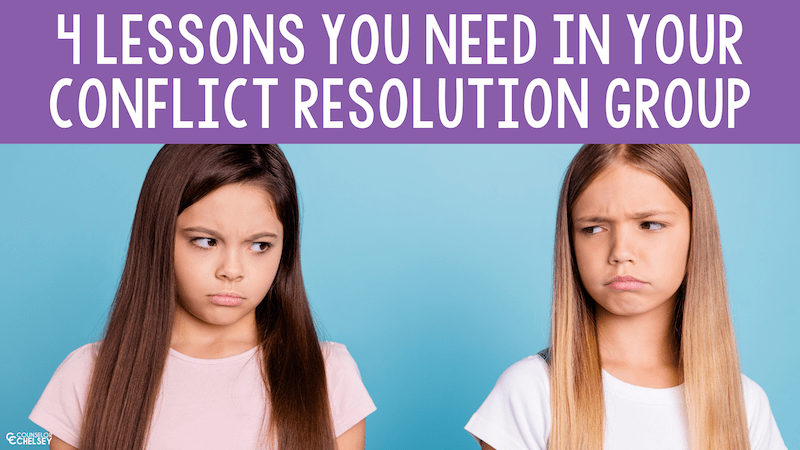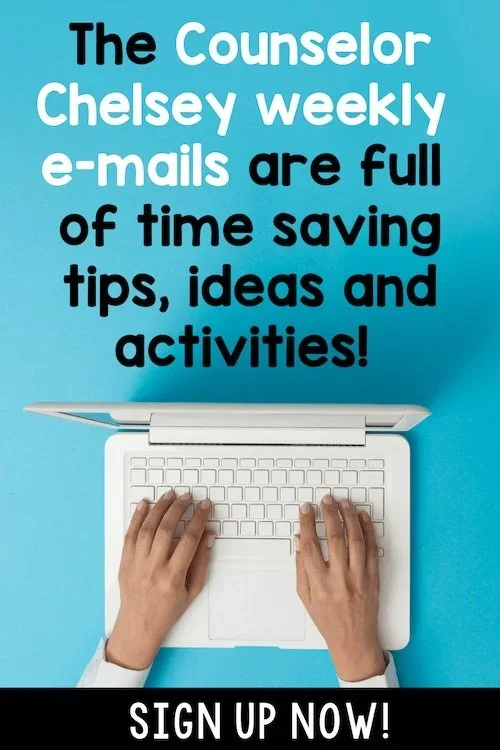4 Topics To Teach In Your Conflict Resolution Small Group
Benjamin Franklin is famous for saying that the only things certain in life are death and taxes. While these things are certainly unavoidable, I’d like to add conflict to the list. The fact that there are no perfect humans means that we are going to do things that hurt others, and that we will be hurt too. Our differences also make it impossible for us to get along all of the time. We each have different wants and needs that don’t always match the wants and needs of the people around us.
Since conflict is unavoidable, it’s important to teach kids the skills necessary to navigate conflict in a healthy and respectful way. That’s why I’ve compiled a list of 4 must-have lessons to include in your next conflict resolution small group, as well as some easy activities to get you started! These ideas will make your lessons stress-free, and will ensure that your students have the skills they need to work through the inevitable conflicts of life.
Lesson 1: What is HEALTHY conflict resolution?
I’ve learned (the hard way) that it’s important to be very clear with the terms we’re using in our instruction. I’ve gone entire lessons assuming that kids understand my terminology, only for them to ask (with 5 minutes left in the lesson) what a specific term means. That’s why it’s important to start out your conflict resolution small group by giving a clear definition and examples of what conflict, and conflict resolution, actually mean.
This sorting activity is included in my Conflict Resolution Interactive Notebook.
I start by defining conflict as “arguments, disagreements, between two people or groups.” After giving kids the definition for the word conflict, I ask them what they think “conflict resolution” means. I explain that it means to resolve - or put and end to - the conflicts.
When talking about conflict resolution, it’s important to note the differences between conflict and bullying. If a child is being bullied, or sees bullying happening, they need to let an adult know.
Once kids have a general understanding of what conflict resolution is, explain that not all ways of resolving conflict are healthy and positive. Healthy conflict resolution is a way to work through the problem in a way that solves the problem in a kind and respectful way.
Activity Idea: Help kids better understand the difference between healthy and unhealthy conflict resolution by giving them examples of both and having them decide whether each example describes healthy or unhealthy conflict resolution. To show their answers, students can sit down if they think the answer is unhealthy, and they can stand up if they think the answer is healthy.
Here are some examples you can use:
Your friend always touches your things. You don’t want her to, but you don’t want her to get mad, so you don’t say anything.
Someone bumped into you on accident, so you pushed them.
You and your friend can’t agree on the rules of the game, so you decide to play something else.
You laughed at a friend for getting the wrong answer, but you apologized and told her that you wouldn’t do it again.
Lesson 2: How To calm down
In session 2 of my no-prep conflict resolution small group, kids will learn how they can calm down and why it’s important.
When teaching about conflict resolution, we might be tempted to stick to the different conflict resolution strategies that kids can use. But, these won’t be as effective if kids aren’t calm when they use the strategies.
Conflict often comes with strong emotions. Unfortunately, this can make it really hard to think clearly and make good decisions. If we make sure that we’re feeling calm, it’s easier to solve the conflict in a more respectful and empathetic way.
One resource that’s very helpful in explaining this concept to kids is the Mind In A Jar. The video gives kids an illustration that will help them understand the importance of calming down, and even guides them through a brief guided meditation exercise.
Once kids understand why it’s helpful to be calm when solving a conflict, take some time to teach them about how they can calm down.
Activity Ideas:
There are so many great coping skills lessons and activities out there, but here are a few of my favorites.
This free Google Slides game will help kids look at different scenarios and decide whether or not they describe positive coping skills.
Split the group into smaller groups and ask them to come up with a coping skill for each letter of the alphabet.
Set up a few stations that give kids a chance to learn about, and practice, different strategies. These coping skills centers are a good place to start, especially if you’re working with younger kids.
Lesson 3: How to communicate
Once kids know how to calm down - and why it’s an important part of conflict resolution - it’s time to talk about communication. When working through a conflict with someone, communication is key. This allows us to truly understand the other person’s perspective, and to communicate our wants and needs in a way that the other person is more likely to hear and understand.
One of my favorite communication tools to teach about is “I-Statements.” An I-statement follows this pattern: “I feel _______, when ________, I want ________.” An I-statement is a great way to share your feelings, wants, and needs without blaming or accusing the other person.
Activity Idea: After teaching your students about how to form an I-statement, practice coming up with I-statements for different conflicts your students might face. Give your group different scenarios or examples, and then have them split up into smaller groups to create an I-statement that could be used in that situation. Then, they can share their responses with each other.
Lesson 4: Conflict Resolution Strategies
Conflict resolution strategies are not one-size-fits-all. Different situations require different strategies. It’s important to help our students learn a variety of tools and techniques that they can use to solve disagreements or arguments with others. The more familiar and comfortable the students are with the strategies, the more likely they will be to use them in their real lives.
Activity Idea: Together as a group, make a list of different ways to solve a conflict. Ideas include sharing, taking turns, compromising, making a plan for next time, etc. Then, split the larger group into smaller groups of 2-3 students. These smaller groups will choose 6 strategies from the list, write them on a piece of paper, and number them 1-6.
Then, the students will take turns rolling a dice. They will look at the strategy that matches the number rolled on the dice and come up with a scenario in which that specific strategy would be helpful. Players can take turns as time permits. To make it into a competition, kids can earn the number of points that correspond with the number they rolled on the dice.
Hopefully, these conflict resolution activities for small group counseling will help get you started! If your group goes longer than 4 sessions, you can always do a few lessons on one of the topics like communication or conflict resolution strategies! I also like to use the last session to review the skills we’ve learned.
Regardless of how you teach the concepts, these skills will help kids learn how to respectfully handle the conflicts they’re certain to face.
If you want your group to be even easier, check out my 6 session NO-PREP conflict resolution small group plan. It includes everything you need to cover the topics we’ve already talked about and more! Plus, it’s completely print and go, which is perfect for busy counselors like you. So, click the black box below to check it out!










